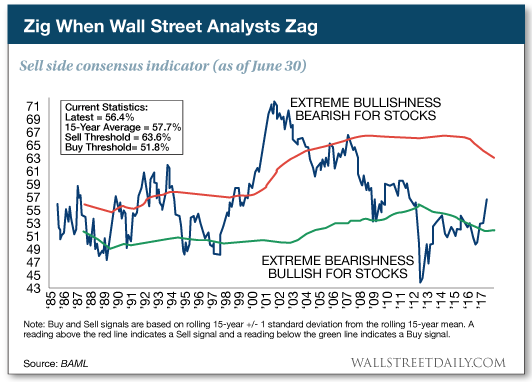If you’re new to the Wall Street Daily nation, here’s the rundown…
I’ve embraced the adage that “a picture is worth a thousand words.” So each Friday, I hand-select compelling graphics to put the week’s investment news into perspective.
All it takes is a quick glance and you’ll be up to speed — this time, regarding analyst sentiment, digital disruption and the dumbest trade in the market.
Whoever said achieving enlightenment isn’t easy? Enjoy!
Consensus or Contrarian
Sell-side analysts are notoriously liberal with their buy ratings and stingy with their sell ratings. At any given time, buy ratings outnumber sell ratings by a factor of 8:1.
Clearly, all those stocks aren’t screaming buys, though. So what are analysts good for? Absolutely nothing — except perhaps serving as a contrarian indicator.
Don’t just take my word for it.
“We have found that Wall Street’s consensus equity allocation has been a reliable contrary indicator,” says Savita Subramanian, the head of equity and quant strategy at Bank of America Merrill Lynch.
“In other words, it has historically been a bullish signal when Wall Street was extremely bearish, and vice versa.”
Where do we stand now? Well, don’t kill the messenger. But the consensus is trending rapidly in a bearish direction.
In fact, the latest survey of Wall Street strategists’ asset allocation recommendations is at its most bullish level since 2011:

We’d be hard-pressed to find an individual analyst that’s calling for an outright end to the eight-year-old bull market. Their collective opinions, however, might be signaling it. Be on guard!
Speaking of caution…
A Mind-Numbingly Dumb Trade
We’ve been chronicling the absence of volatility in the stock market for months now (see “O Volatility, Volatility, Wherefore Art Thou, Volatility?”).
And we’ve struck a cautious (not cavalier) tone. That is, we should expect volatility to return with a vengeance — and prepare for it. Either by going long the CBOE Volatility Index (VIX) or by implementing trailing stops to protect your profits in the event of any sudden and severe market sell-offs.
Go figure. It appears that the investing herd is doing exactly the opposite. They’re betting that the placidity continues.
According to Macro Risk Advisors (MRA), a firm that arranges volatility trades, anti-volatility bets on the VelocityShares Daily Inverse VIX Short Term linked To SP 500 VIX Short Fut Exp 4 Dec 2030 (NASDAQ:XIV) are surging.
A single day in late June witnessed $3.3 billion worth of bets that U.S. stocks will essentially trade flat. As you can see in the chart, this is becoming an extremely crowded trade:

What’s most concerning is the “growing interest in shorting volatility among retail and others who are not specialists in volatility trading,” says Pravit Chintawongvanich, the head of derivatives strategy at MRA.
Don’t fall into the trap.
When a sudden unexpected spike in volatility hits — and it will — anyone making this mind-numbingly dumb trade is going to be in a world of hurt.
Now it’s back to the hurt…
Disruption Quantified
We’ve spilled a ton of pixels here identifying the winners of the smartphone boom. From personal experience, we know the losers — MP3 players, digital cameras, GPS devices and camcorders (remember those?).
But this graphic puts the drubbing into perspective. It shows the decline in sales for the various gadgets since the introduction of the first iPhone in 2007:

I know it’s hard to imagine a time without smartphones. But if history is any guide, a different electronic gadget will dominate our lives in less than 10 years.
Any guesses? Augmented reality headsets? Voice assistants like Amazon’s Alexa?
Put on your Nostradamus hat and let us know what you think in the comments section on our website, or by emailing us at wallstreetdaily@agorafinancial.com.
